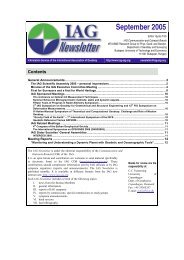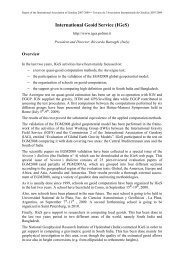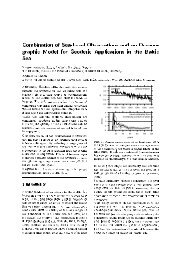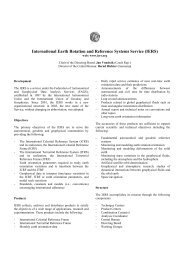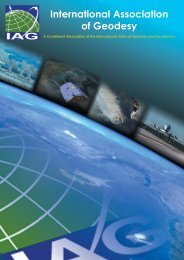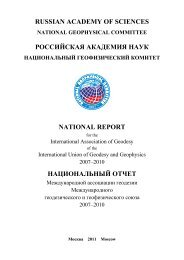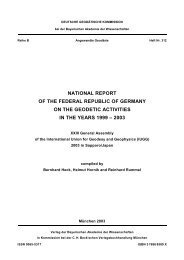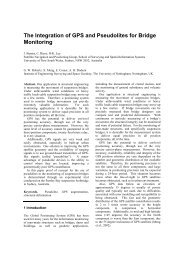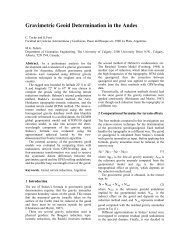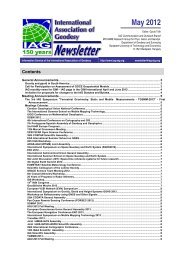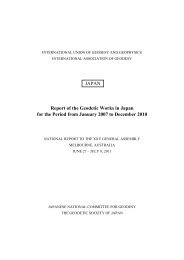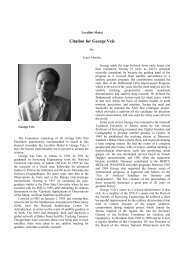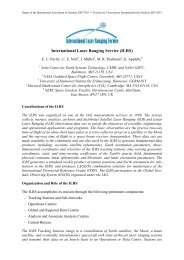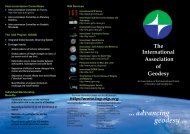Report of the International Association of Geodesy 2007-2011 ─ Travaux de l’Association Internationale de Géodésie 2007-2011– Promote the use of st<strong>and</strong>ard procedures for geodetic data, in particular GPS data, qualityevaluation <strong>and</strong> processing.The need to involve different research areas dem<strong>and</strong>s for collaboration with different IAG<strong>Commission</strong>s <strong>and</strong> in particular with <strong>Commission</strong> 1 <strong>and</strong> <strong>Commission</strong> 3. <strong>Commission</strong> 1 isresponsible for regional <strong>and</strong> global reference frames, for the coordination of space techniques<strong>and</strong> for satellite dynamics. WEGENER can contribute significantly to each one of these areas<strong>and</strong>, in particular, to regional <strong>and</strong> global reference frames by making available, in its studyarea, quality-tested regional data sets acquired with different space <strong>and</strong> terrestrial techniques,as well as relevant quality-tested solutions. Additionally WEGENER can contribute bycarrying out studies, already being developed by WEGENER member groups, on thedefinition of effective integrated observational strategies. <strong>Commission</strong> 3, is responsible forearth rotation <strong>and</strong> geodynamics. WEGENER will provide its main contribution in the field ofgeodynamics by studying, regionally, both short <strong>and</strong> long-term crustal motions.ObjectivesThe primary goals of the WEGENER project are to:– Provide a framework for geodetic/geophysical/geological cooperation in the study of theEurasian/African/Arabian plate boundary zone;– Foster the use of space-borne, airborne <strong>and</strong> terrestrial hybrid techniques for earthobservation;– Define effective integrated observational strategies for these techniques to reliablyidentify <strong>and</strong> monitor crustal movements <strong>and</strong> gravity field variations over all time-scales;– Facilitate <strong>and</strong> stimulate the integrated exploitation of data from different techniques in theanalysis <strong>and</strong> interpretation of geoprocesses;– Organize periodic meetings with special emphasis on interdisciplinary research <strong>and</strong>interpretation <strong>and</strong> modeling issues;– Reinforce cooperation with African <strong>and</strong> Arabian countries <strong>and</strong> colleagues, which can bothcontribute to underst<strong>and</strong>ing the kinematics <strong>and</strong> dynamics of the Eurasian/African/Arabianplate boundary zone <strong>and</strong> promote the growth of such research in these countries.Activities– A GEODynamic Analysis Center (GEODAC) was established at the University of Porto(http://geodac.fc.up.pt). The main objective of GEODAC is to provide automatic analysisof GNSS time series to estimate the station velocity based on the Maximum LikelihoodEstimation method <strong>and</strong> assuming a power-law plus white noise model. It is well knownthat such an approach provides realistic error bars because it takes into account thetemporal correlations that exist in the signal. After free registration, the user can uploadhis GNSS time-series which will be processed <strong>and</strong> afterwards the results are presented infigures <strong>and</strong> tables. The web service uses proprietary software developed at the Universityof Porto (Bos et al., 2008).– Strategies are being discussed <strong>and</strong> developed to integrate geological, geophysical, <strong>and</strong>geodetic observations to address a broad range of questions related to tectonic,atmospheric, oceanic, <strong>and</strong> climatic issues of interest to the earth science community (e.g.,Zerbini et al. 2007; Zerbini et al. 2010).
Report of the International Association of Geodesy 2007-2011 ─ Travaux de l’Association Internationale de Géodésie 2007-2011– WEGENER members actively fostered the co-operation with the African countries in theframework of AFREF (AFrican REference Frame) <strong>and</strong> other specific scientific projects.Such collaborations extend to the entire continent since that it is necessary to underst<strong>and</strong>the geodynamics of the different African tectonic units (Nubia, Somalia <strong>and</strong> other blocksin the East African Rift) in order to properly constrain the interaction between thesetectonic plates with Eurasia <strong>and</strong> Arabia In this respect, new GNSS stations have beeninstalled in several countries by the WEGENER community (e.g., Ethiopia, Eritrea,Morocco, Egypt, Cape Verde, S. Tomé e Príncipe, Malawi, Tanzania, Mozambique,Mauritius). WEGENER PI-driven projects are providing new constraints on fault sliprates throughout the Arabia-Africa-Eurasia zone of plate interaction (e.g., Ferry et al.,2007; Nemer et al., 2008; Sbeinati et al., 2010; Ferry et al., 2011; Reilinger et al., 2009,Vernant et al., 2009, Alchalbi et al., 2009), on the earthquake deformation cycle (Hearn etal., 2009, Ergintav et al., 2009), as well as the kinematics <strong>and</strong> dynamics of plate-scaleinteractions (e.g., ArRajehi et al., 2010, McClusky et al., 2010, Perouse et al., 2010), Inaddition, WEGENER members are collaborating with AFREF Scientific Committee inthe definition <strong>and</strong> implementation of procedures to compute the first AFREF solution.Results for the first two epochs were presented at IAG meetings (e.g., Fern<strong>and</strong>es et al,2009).– In the framework of the IAG GGOS project, WEGENER contributes to the activities ofsubtask DA-09-02-c (Global Geodetic Reference Frames) of the Group on <strong>Earth</strong>Observations (GEO).– Every two years General Assemblies are organized to serve as a high-level internationalforum, in which scientists from all over the world can discuss multidisciplinaryinterpretation of geodynamics, <strong>and</strong> strengthen the collaboration between Countries.1. The 14 th General Assembly with the title “WEGENER: an interdisciplinary approachto <strong>Earth</strong> science research <strong>and</strong> modelling” was hosted by the Institute of PhysicalGeodesy at the Conference Center of the Technische Universität Darmstadt onSeptember 15-18, 2008 (http://www.ipg.tu-darmstadt.de/projekte/wegener2008/home/index.de.jsp). There were 86 participants from 18 nations. The program wasarticulated around five major sessions: Current plate motions <strong>and</strong> inter- <strong>and</strong> intraplatedeformations. Focusing on Europe, the Mediterranean <strong>and</strong> surrounding regions;Contribution of new <strong>Earth</strong> observation systems <strong>and</strong> methodologies; The GlobalGeodetic Observing System (GGOS) <strong>and</strong> its regional implementations; Open Session:Geosciences from Northern Africa to Central <strong>and</strong> Northern Europe; Special Session:The Mediterranean: A geohazards focus area. More than 70 oral presentations weremade. A special issue of the Journal of <strong>Geodynamics</strong> compiles 16 selected manuscriptsderived from such presentations (JoG, vol. 49, 2010).2. The 15 th General Assembly that celebrated the 30 th anniversary of the project was heldin Istanbul, Turkey, on September 14-17, 2010 <strong>and</strong> was hosted by the GeodesyDepartment of K<strong>and</strong>illi Observatory <strong>and</strong> <strong>Earth</strong>quake Research Institute of the BogaziciUniversity at the Albert Long Hall Conference Center (http://www. koeri.boun.edu.tr/jeodezi/wegener2010/ . There 96 participants from 15 countries. The program wasorganized according to the following four main sessions: 30 Years of WEGENER -The Evolution of our Knowledge about the Africa-Eurasia Plate Boundaries; CurrentPlate Motions, Inter- <strong>and</strong> Intraplate Deformation with a Focus on Europe, theMediterranean, Northern Africa <strong>and</strong> the Middle East; <strong>Earth</strong> Observation Systems <strong>and</strong>Reference Frames, Observation Techniques, Methods <strong>and</strong> Data Analysis; Open Sessionwith Proposed Focus on International Organization of Geodetic Initiatives Contributingto <strong>Earth</strong> Sciences. The Journal of <strong>Geodynamics</strong> agreed upon publishing a special issue



